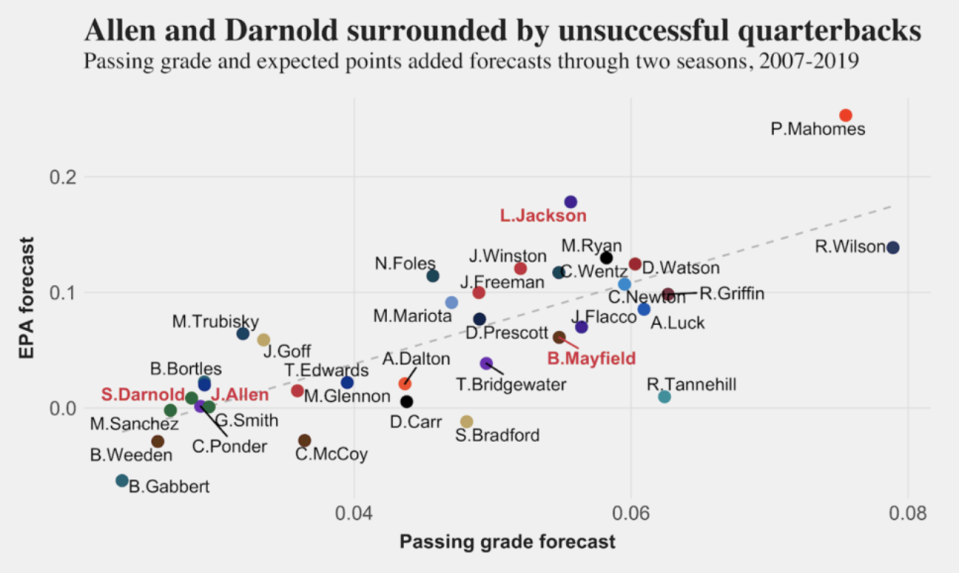Bills' Josh Allen, Jets' Sam Darnold need breakout seasons to avoid path of mediocrity
By Kevin Cole
The Buffalo Bills and New York Jets hope to contend in a suddenly wide-open AFC East. There aren’t many superficial similarities between the two teams. The Bills are a strong contender to win the division, while the Jets are hoping merely to compete. What they have in common are quarterbacks entering make-or-break seasons.
The perception of Josh Allen in Buffalo is of a QB on the rise, yet over the past two seasons he ranks among the bottom-10 quarterbacks in PFF passing grade and efficiency metrics like expected points per play. Sam Darnold has had similarly disappointing grades and stats.
For both teams and fan bases, the hope is that this is the season their respective quarterback breaks out and becomes a true franchise option.
That possibility might be more remote than it seems.

Why Josh Allen, Sam Darnold need big statistical reversal
Earlier this year, I looked at the careers of the 2018 quarterback class and found that Allen and Darnold trailed far behind Baker Mayfield and Lamar Jackson in projections. When I plotted their projections for PFF passing grade and efficiency (measured by expected points added per dropback), they were nestled into a cohort of passers who never turned the corner in the NFL.

The names that surround Allen and Darnold are some of the bigger failed QB picks of the past 15 years, such as Geno Smith, Blake Bortles and Christian Ponder. The likelihood of Allen and Darnold breaking out in the rest of their careers looks slim, but keep in mind that the sample here is still limited to fewer than 40 quarterbacks.
In this analysis, I’m going to look back to all quarterbacks drafted since 1975 to build a much more substantial sample. With this larger group, we find a cohort of quarterbacks who struggled over their first two seasons before going on to become efficient players. A path to success exists for Allen and Darold, but we have to study what attributes were most correlated with success in the past.
Since we don’t have PFF grades or expected points added before 2007, I’m going to use another efficiency metric to rate quarterback plays: adjusted net yards per attempt (ANY/A). The calculation is passing yards minus sack yards, a bonus for touchdowns (+20) and discount for interceptions (-45). All of this is divided by the total number of attempts plus sacks. ANY/A is one of the best explanatory stats available.
ANY/A gives an estimate for how efficient a quarterback was when they dropped back to pass, whether the play was incomplete, complete, a sack, a touchdown or an interception. Pro Football Reference has taken the numbers for ANY/A and all of its components and scaled them based on the playing environment at the time, with 100 being the league average.
Allen and Darnold were below average (less than 100) in total efficiency as measured by ANY/A in each of their first two seasons. Of the 153 quarterbacks who were drafted between 1975-2017 and had at least 30 career starts, 33 started their first two seasons and didn’t have an average efficiency year like Allen and Darnold. Of those 33, only nine went on to post above-average efficiency in the next five seasons (Years 3-7).
Here are the numbers for each stat adjusted to era. The number in the parentheses indicates the season of experience, e.g. 1 equals the quarterback’s rookie season.

Hall of Famer Troy Aikman makes the list, which means all hope isn’t lost after a couple of bad seasons to start a quarterback’s career. But Aikman was dropped into one of the worst situations to start his career as the Dallas Cowboys went 8-24 over his first two seasons. Aikman also started his career in 1989, a different era for QB play. The only quarterbacks of the nine who turned around a slow career start to be drafted in the past 20 years are Andy Dalton and Vince Young, neither the best of outcomes.
Glancing through the second-year components for the turnaround successes, you’ll see that the one most often above average (greater than or equal to 100) is completion percentage. Five of the nine turnaround quarterbacks had above-average completion percentages in their second seasons.
Why Darnold and Allen can be anomalies to trend
The strong predictive power of completion percentage is relatively poor news for Darnold, whose Cmp%+ in the table below was 91 last season, and especially bad for Allen, who posted a Cmp%+ of 80.

The best component for Darnold in 2019 was sack avoidance, which is negatively correlated with a breakout. For Allen, it was interception avoidance, which has little predictive power for breaking out.
Allen and Darnold aren’t doomed to failure, but their paths to success would be anomalies. Of the two, there are more excuses for a player like Darnold who has played with bottom-tier surrounding casts and suffered through injuries and coaching changes.
The important thing to look for early this coming season is who can consistently complete passes at or above a league-average rate.
For more statistical analysis of the NFL, go to PFF.com
More from Yahoo Sports:
